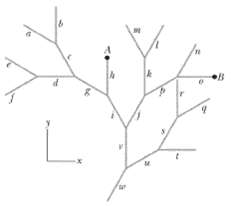Typical backyard ants often create a network of chemical trails for guidance. Extending outward from the nest,
Question:
Typical backyard ants often create a network of chemical trails for guidance. Extending outward from the nest, a trail branches (bifurcates) repeatedly, with 60o between the branches. If a roaming ant chances upon a trail, it can tell the way to the nest at any branch point: If it is moving away from the nest, it has two choices of path requiring a small turn in its travel direction, either 30o leftward or 30" rightward. If it is moving toward the nest, it has only one such choice. Figure shows a typical ant trail, with lettered straight sections of 2.0 cm length and symmetric bifurcation of 60o. What are the
(a) Magnitude and
(b) Angle (relative to the positive direction of the superimposed x axis) of an ant's displacement from the nest (find it in the figure) if the ant enters the trail at point A? What are the
(c) Magnitude and
(d) Angle if it enters at point B?

Step by Step Answer:

Fundamentals of Physics
ISBN: 978-0471758013
8th Extended edition
Authors: Jearl Walker, Halliday Resnick





